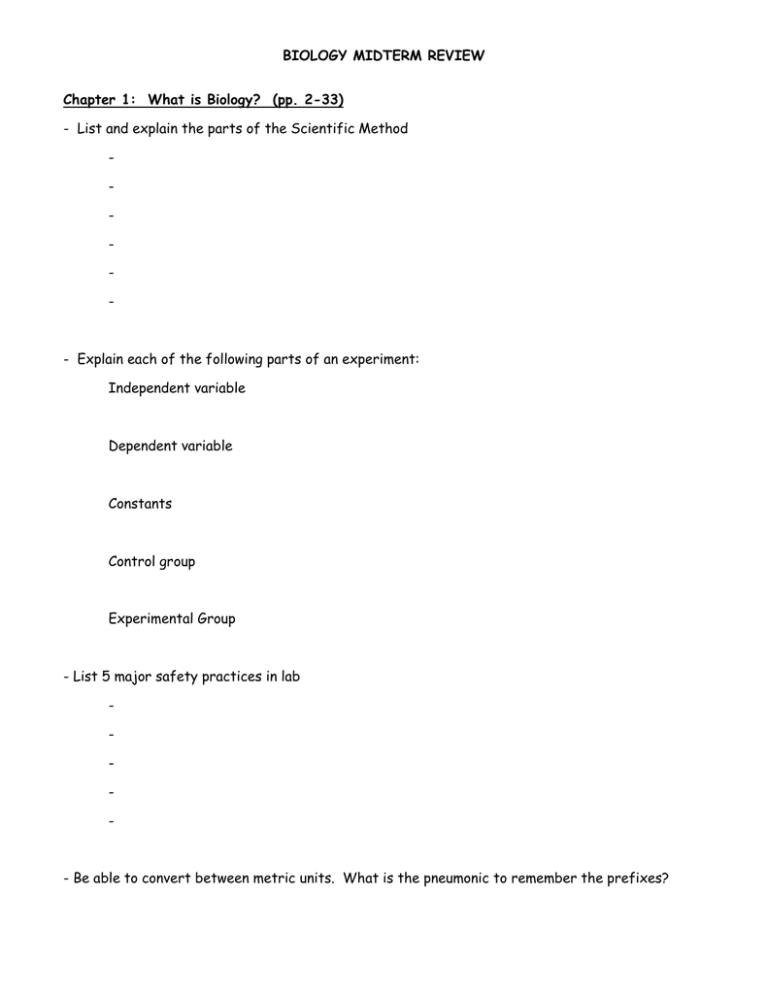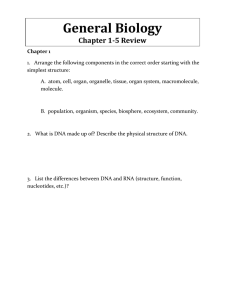BIOLOGY MIDTERM REVIEW Chapter 1: What is Biology? (pp. 2
advertisement

BIOLOGY MIDTERM REVIEW Chapter 1: What is Biology? (pp. 2-33) - List and explain the parts of the Scientific Method - - Explain each of the following parts of an experiment: Independent variable Dependent variable Constants Control group Experimental Group - List 5 major safety practices in lab - - Be able to convert between metric units. What is the pneumonic to remember the prefixes? - What are the 4 Basic units of measurement in the Metric system, and what do they measure? - - Explain the 7 characteristics of living things we discussed in class - Explain/identify the 10 levels of organization we discussed in class starting with molecules - ADDITIONAL VOCABULARY: hypothesis theory homeostasis metabolism Chapter 18: Classification (pp. 446-465) - What are the 4 main reasons to classify? - - By what kind of characteristics were organisms originally classified? - What was Linneaus' system? What problems did he fix? - What is binomial nomenclature? What was Linneaus' hierarchy? (remember the pneumonic!) - - What are the modern levels of classification? (include the new level) - Explain the modern ways of classifying (explain cladograms and molecular clocks) - How many Kingdoms are there? How many Domains? - What are the main characteristics of each of the Kingdoms? - Be able to use dichotomous keys and cladograms ADDITIONAL VOCABULARY: taxonomy genus taxon evolutionary classification derived characteristics Chapter 2: The Nature of Matter (pp. 35-57) - What are the three subatomic particles of an atom? What are their characteristics? Where are they found in the atom? - What are isotopes? - What are ions? - What are elements? - What are compounds? - How are ionic and covalent bonds the same? How are they different? - What is polarity? - What are solutions/suspensions? - What is pH? - What are acids? Bases? - What is a buffer? (remember all three parts of the definition!) Fill in the following chart: (USE THE CHART FROM CLASS!!!) Organic compound Monomer Elements Carbohydrate Lipid Protein Nucleic acid - Give functions and examples of each of the 4 organic molecules listed in the last question Molecule Function - What are enzymes? - What is activation energy? Example - What is an exergonic reaction? An endergonic reaction? ADDITIONAL VOCABULARY: atom atomic number atomic mass nucleus cohesion adhesion mixture solvent solute reactant product substrate Chapter 7: Cell Structure and Function (pp 168-197) - What are the three parts of the cell theory? - Who were the scientists involved in biogenesis/abiogenesis? What did they do? Who was for abio? Who was for bio? - - Who were the scientists involved in the development of the cell theory? What was their contributions? - - Who do you determine total magnification of a microscope if you have an eyepiece of 10X, and objectives of 4X, 10X, and 40X? What are those lenses named? - What are the similarities/differences between prokaryotes and eukaryotes? - What are the similarities/differences between plants and animals? - What are the functions of the main organelles we studied? - cell membrane - cell wall - nucleus - cytoplasm -chromosomes - nucleolus - ribosomes - rough endoplasmic reticulum - smooth endoplasmic reticulum - golgi bodies - lysosomes - vacuoles - chloroplasts - mitochondria - Explain the 6 ways of getting things in/out of cells. What is unique about each one? (USE THE CHART FROM NOTES!!!!!) - - What are the different solutions (isotonic, hypertonic, hypotonic) and what happens to cells in those solutions? - Why aren't cells the size of a basketball? (two main reasons) Explain Chapter 10: Cell Growth (pp. 241-257) - What is interphase? Describe the three parts of it. - Explain the 4 parts of MITOSIS. Draw a picture of each phase as you explain - What do cyclins do? What do internal cyclins regulate? What do external cyclins regulate? - What happens when regulation no longer works? Chapter 8: Energy and Life (pp 200-219) - What are autotrophs? What are heterotrophs? - What is ATP? Where is its energy stored? How is its energy released? - What is NADPH? Where is its energy stored? - What is a pigment? What pigment makes plants green? - What is important about absorbed light? What kind of light do plants absorb? - What is the equation for photosynthesis? - What happens during the light dependent reactions? Where in the chloroplast does it take place? - What happens during the Calvin Cycle? Where in the chloroplast does it take place? KEEP IN MIND: THIS IS INTENDED FOR REMINDING YOU OF THINGS WE HAVE COVERED. IT IS NOT INCLUSIVE. LOOK OVER NOTEBOOK (OLD WORKSHEETS, NOTES, VOCAB, TESTS QUIZZES, LABS) ALL MATERIAL IS FAIR GAME!!





